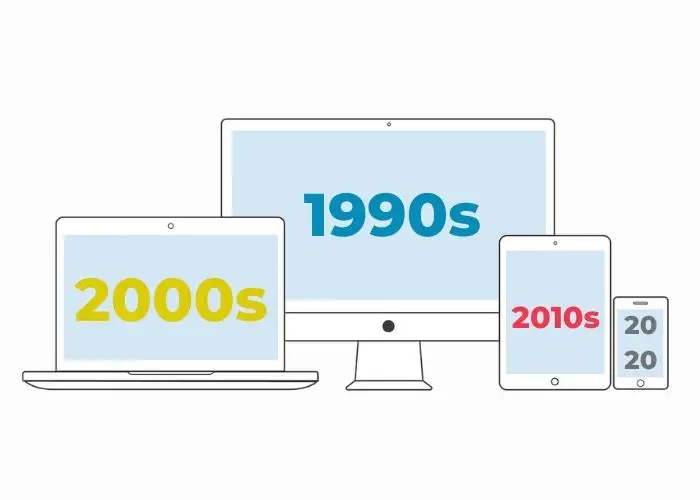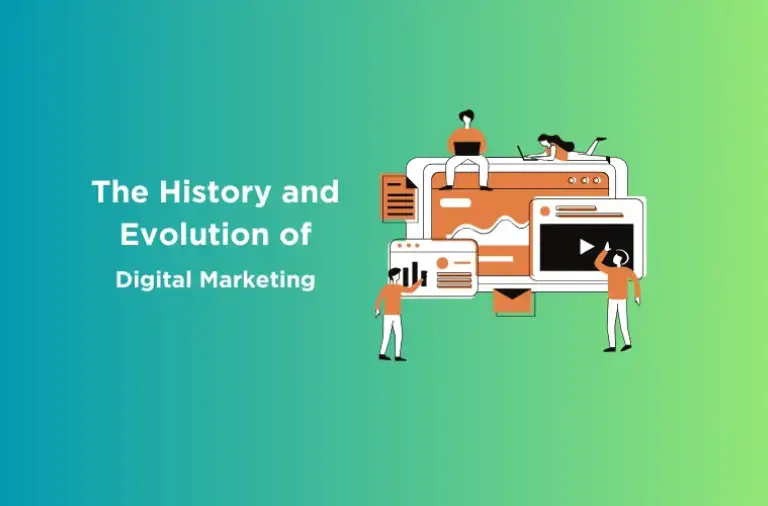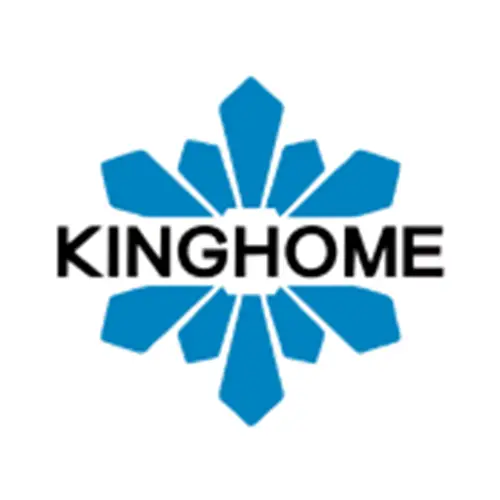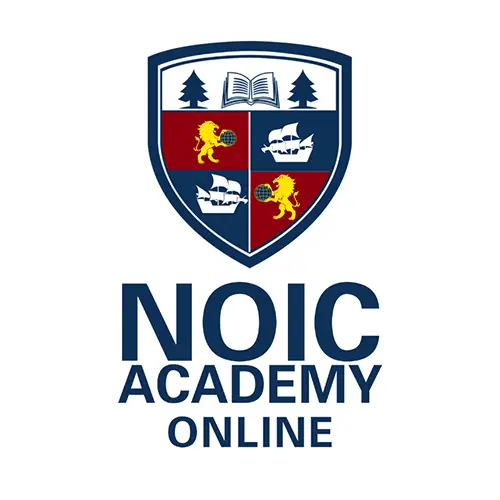In today’s digital era, where over 170 million people actively use social media, understanding the history and evolution of digital marketing is essential for business owners. Digital marketing, at its core, involves promoting products and services through the Internet and other electronic channels. According to the Digital Marketing Institute, it is defined as “the use of digital channels to promote or market products and services to targeted consumers and businesses.”
As digital content becomes a central part of everyday life, traditional marketing methods are rapidly being replaced by digital alternatives. Exploring the history of digital marketing helps illustrate how it has evolved into a cost-effective and powerful tool for businesses. Unlike traditional strategies, digital marketing offers a more targeted, affordable approach, making it indispensable for companies striving to succeed in today’s competitive market.
The Benefits of Digital Marketing
Digital marketing provides businesses with numerous advantages, enabling them to reach wider audiences and improve marketing efficiency. As digital platforms and technologies continue to advance, companies can now engage with consumers in ways that were once impossible.
- Enhanced Engagement – Foster long-term relationships with customers through social media, email marketing, and other digital channels.
- Expanded Reach – Connect with a larger audience in a shorter time using social media, search engines, and websites.
- Cost-Effective Solutions – Digital marketing provides affordable marketing options with higher returns on investment (ROI) compared to traditional methods.
- Targeted Advertising – Utilize data-driven insights to tailor campaigns and reach specific demographics effectively.
- Global Access – Overcome geographical limitations to engage with customers worldwide.
- Real-Time Interaction – Communicate directly with customers in real-time, improving responsiveness and engagement.
- Measurable Performance – Leverage analytics tools to track campaign success and make data-driven decisions.
The History of Digital Marketing
Digital marketing traces its roots back to the 1990s with the advent of the internet and the development of Web 1.0. This early version of the web provided access to information but lacked interactivity. Many marketers were initially hesitant about digital platforms due to their limited capabilities.
A significant breakthrough came in 1993 with the introduction of the first clickable banner ad. HotWired was among the pioneers in leveraging banner ads, marking a turning point for digital advertising. The launch of Yahoo in 1994—originally called “Jerry’s Guide to the World Wide Web”—further accelerated the digital marketing landscape, as businesses began optimizing their websites to rank better in search engines. By 1996, search engines such as HotBot, LookSmart, and Alexa emerged, fueling the industry’s growth.
The landscape underwent a major shift in 1998 with the debut of Google, followed by Microsoft’s MSN search engine and Yahoo’s web search. Although the dot-com bubble burst in 2000, it cleared the way for dominant players like Google to shape the next phase of digital marketing. By 2006, search engine traffic had skyrocketed, with approximately 6.4 billion searches conducted in a single month. To remain competitive, Microsoft rebranded MSN as Live Search.
With the rise of Web 2.0, digital marketing underwent a revolutionary transformation. This era shifted users from passive content consumers to active participants, enabling real-time interaction between businesses and audiences. By 2004, internet advertising in the U.S. had generated $2.9 billion, solidifying digital marketing as a fundamental business strategy.
Social networking platforms soon became a driving force in digital marketing’s evolution. MySpace was the first major social media platform, followed by Facebook, which revolutionized the way businesses engaged with consumers. Companies quickly recognized the potential of social media, using it to market their products and build brand awareness. This shift opened new opportunities and reshaped marketing strategies.
Another key milestone was the introduction of cookies, which allowed marketers to track user behaviour and tailor content to individual preferences. Originally designed to record browsing habits, cookies evolved into essential tools for personalized marketing strategies.
By 2014, social media had become a dominant force, with Americans spending an average of 37 minutes per day on social platforms. Social media marketing proved highly effective, with 70% of B2C marketers acquiring customers through Facebook. Given its widespread use, Facebook ad strategies have become a crucial component of modern digital campaigns.
Marketers are increasingly adopting top Facebook ad hacks that deliver results, using advanced targeting options and creative strategies to enhance ad performance and drive higher engagement. Today, digital marketing ensures that products and services are accessible 24/7, reinforcing its role as an essential business tool.
The history and evolution of digital marketing highlight its transformation into a powerful method for reaching broader audiences, building strong customer relationships, and achieving measurable success in the digital age.
Evolution of Digital Marketing: A Timeline
Digital marketing has undergone significant transformations over the decades, evolving into a multi-billion-dollar industry. Here’s a look at its key milestones:

The 1990s: The Foundations of Digital Marketing
- The first search engine, Archie, emerged in the early 1990s, marking the beginning of search technology.
- Search Engine Optimization (SEO) began to gain importance as a strategy for online visibility.
- Clickable web banner ads debuted in 1994, transforming online advertising.
- The first recognizable social media platform launched in 1997, quickly amassing 3.5 million users.
- Google and Yahoo’s web search launched in 1998, shaping the digital landscape.
The Early 2000s: Growth and Transformation
- The dot-com bubble burst, but new platforms like LinkedIn, MySpace, WordPress, and Facebook emerged.
- Mobile text messaging gained popularity, leading to the rise of mobile marketing.
- Businesses increasingly focused on social media engagement and Pay-Per-Click (PPC) advertising.
The Mobile Revolution (Late 2000s – 2010s)
- Digital marketing saw rapid expansion with the rise of e-commerce, led by Amazon surpassing $10 billion in sales.
- Mobile apps such as WhatsApp, Instagram, and Snapchat reshaped consumer engagement.
- Mobile-first strategies became crucial, prompting businesses to optimize their marketing for smartphones and tablets.
The Present: The Dominance of Digital Marketing
- Mobile devices now account for 65% of digital media consumption.
- The digital advertising industry has grown to approximately $200 billion, with Google AdWords generating 96% of Google’s revenue.
- Social networking platforms remain at the forefront of digital marketing, with 3.1 billion online users worldwide.
- Influencer marketing has become a $1 billion industry, largely driven by Instagram and blogging platforms.
Conclusion
The history and evolution of digital marketing have dramatically reshaped how businesses connect with consumers. From early clickable banner ads to the rise of social media and mobile-first strategies, digital marketing has continuously adapted to meet the changing needs of businesses and audiences alike. Today, it stands as an indispensable tool for reaching wider audiences, fostering meaningful relationships, and achieving measurable success.
As digital marketing continues to evolve with emerging technologies and trends, understanding its journey is essential for businesses seeking to stay competitive and innovative in an ever-changing digital landscape.























